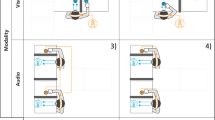Abstract
Do interlimb rhythmic coordinations between individuals exhibit the same relations among the same observable quantities as interlimb rhythmic coordination within an individual? The 1∶1 frequency locking between the limbs of two people was investigated using a paradigm in which each person oscillated a hand-held pendulum, achieving and maintaining the mutual entrainment through vision. The intended coordination was antiphase, φ=π, and the difference between the uncoupled eigenfrequencies, Δω, was manipulated through differences in the lengths of the two pendulums. The mean phase relation and its variance for visually coupled coordinations differing in Δω were predicted by an order parameter equation developed by Haken et al. (1985) and Schöner et al. (1986) for the relative phase of correlated movements of limb segments. Specifically, the experiment revealed that: (1) the deviation of φ from π increased with increasing deviation of Δω from 0; and (2) fluctuations in φ increased with increasing deviation of Δω from 0. With deviations of Δω from 0, new peaks were added at higher harmonics in φ's power spectrum. These results were in agreement with previous research on the stable states of interlimb coordination within a person, mediated by mechanoreceptive rather than photoreceptive mechanisms. Additionally, they were in agreement with previous research on phase transitions in interlimb coordination which have been shown to conform to the same order parameter dynamics whether the coupling be mechanoreceptively or photoreceptively based. It was suggested that phase entrainment in biological movement systems may abide by dynamical principles that are indifferent to the details of the coupling.
Similar content being viewed by others
References
Beek PJ (1989) Timing and phase locking in cascade juggling. Ecol Psychol 1:55–96
DeGuzman, GC, Kelso JAS (1991) Multifrequency behavioral patterns and the phase attractive circle map. Biol Cybern 64:485–495
Garfinkel A (1987) The slime mold Dictyostelium as a model of self-organization in a social system. In: Yates FE (ed) Self-organizing systems; the emergence of order. Plenum, New York, pp 181–212
Haken H (1977/1983) Advanced synergetics. Springer, Berlin Heidelberg New York
Haken H (1988) Information and self-organization. Springer, Berlin Heidelberg New York
Haken H, Kelso JAS, Bunz H (1985) A theoretical model of phase transitions in human hand movements. Biol Cybern 51:347–356
Holst E von (1937/1973) On the nature and order of the central nervous system. In: Martin R (ed) The collected papers of Erich von Holst, vol 1. The behavioral physiology of animal and man. University of Miami Press, Coral Gables, Fla
Keith WL, Rand RH (1984) 1∶1 and 2∶1 phase entrainment in a system of two coupled limit cycle oscillators. J Math Biol 20:133–152
Kelso JAS (1984) Phase transitions and critical behavior in human bimanual coordination. Am J Phys Reg Integr Comp 15:R1000-R1004
Kelso JAS, Scholz JP, Schöner G (1986) Nonequilibrium phase transitions in coordinated biological motion: critical fluctuations. Phys Lett 118:279–284
]Kelso JAS, Delcolle JD, Schöner G (1990) Action-perception as a pattern formation process. In: Jeannerod M (ed) Attention and performance XIII. Erlbaum, Hillsdale, NJ, pp 139–169
Kelso JAS, DeGuzman GC, Holroyd T (1991) The self organized phase attractive dynamics of coordination. In: Babloyantz A (eds) Self organization, emerging properties and learning. Plenum, New York
Kugler PN, Turvey MT (1987) Information, natural law and the self-assembly of rhythmic movement. Erlbaum, Hillsdale, NJ
Press WH, Flannery BP, Teukolsky SA, Vetterling WT (1988) Numerical recipes in C: the art of scientific computing. Cambridge University Press, Cambridge, UK
Rand RH, Cohen AH, Holmes PJ (1988) Systems of coupled oscillators as models of central pattern generators. In: Cohen A H, Rossignol S, Grillner S (eds) Neural control of rhythmic movements in vertebrates. Wiley, New York, pp 333–367
Schmidt RC, Carello C, Turvey MT (1990) Phase transitions and critical fluctuations in the visual coordination of rhythmic movements between people. J Exp Psychol Hum Percept Perform 16:227–247
Schmidt RC, Beek PJ, Treffner PJ, Turvey MT (1991) Dynamical substructure of coordinated rhythmic movements. J Exp Psychol: Hum Percept Perf 17:635–651
Schmidt RC, Shaw BS, Turvey MT (1993) Coupling dynamics in interlimb coordination. J Exp Psychol Hum Percept Perform 19:397–415
Scholz JP, Kelso JAS, Schöner G (1987) Nonequilibrium phase transitions in coordinated biological motion: critical slowing down and switching time. Phys Lett A 123:390–394
Schöner G, Kelso JAS (1988) Dynamic pattern generation in behavioral and neural systems. Science 239:1513–1520
Schöner G, Haken H, Kelso JAS (1986) A stochastic theory of phase transitions in human hand movement. Biol Cybern 53:442–452
Sternad D, Turvey MT, Schmidt RC (1992) Average phase difference theory and 1∶1 phase entrainment in interlimb coordination. Biol Cybern 67:223–231
Tinbergen N (1951) The study of instinct. Oxford University Press, Oxford
Turvey MT, Schmidt RC (1993). A low-dimensional nonlinear dynamic governing interlimb rhythmic coordination. In: Swinnen SP et al. (eds) Interlimb coordination: neural, dynamical, and cognitive constraints. Academic Press, New York (in press)
Turvey MT, Rosenblum LD, Schmidt RC, Kugler PN (1986) Fluctuations and phase symmetry in coordinated rhythmic movements. J Exp Psychol Hum Percept Perform 12:564–583
Turvey MT, Schmidt RC, Rosenblum LD, Kugler PN (1988) On the time allometry of coordinated rhythmic movements. Theor Biol 130:285–325
Winfree AT (1980) The geometry of biological time. Springer, Berlin Heidelberg New York
Yates FE (1987) Self-organizing systems: the emergence of order. Plenum, New York
Author information
Authors and Affiliations
Rights and permissions
About this article
Cite this article
Schmidt, R.C., Turvey, M.T. Phase-entrainment dynamics of visually coupled rhythmic movements. Biol. Cybern. 70, 369–376 (1994). https://doi.org/10.1007/BF00200334
Received:
Accepted:
Issue Date:
DOI: https://doi.org/10.1007/BF00200334




